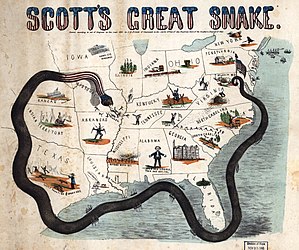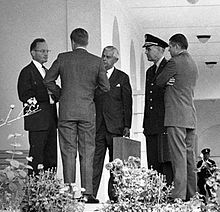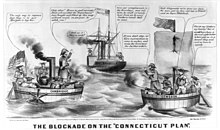Blockade
This articleneeds additional citations forverification.(May 2022) |


| Part of a series on |
| War (outline) |
|---|
 |
Ablockadeis the act of actively preventing a country or region from receiving or sending outfood,supplies,weapons,orcommunications,and sometimes people, bymilitary force. A blockade differs from anembargoorsanction,which are legal barriers to trade rather than physical barriers. It is also distinct from asiegein that a blockade is usually directed at an entire country or region, rather than a fortress or city and the objective may not always be to conquer the area.
A blockading power can seek to cut off all maritime transport from and to the blockaded country, although stopping all land transport to and from an area may also be considered a blockade. Blockades restrict the trading rights of neutrals, who must submit for inspection for contraband, which the blockading power may define narrowly or broadly, sometimes including food and medicine. In the 20th century,air powerhas also been used to enhance the effectiveness of blockades by halting air traffic within the blockaded airspace.
Close patrol of hostile ports, in order to prevent naval forces from putting to sea, is also referred to as a blockade. When coastal cities or fortresses were besieged from the landward side, the besiegers would often blockade the seaward side as well. Most recently, blockades have sometimes included cutting off electronic communications byjamming radiosignals and severingundersea cables.Blockades often result in the starvation of the civilian population, notably during theblockade of GermanyduringWorld War Iand theblockade of Biafraduring theNigerian Civil War.[1]
According to modern international law, blockades are an act of war.[2]When used as a part of an effort to starve the civilian population, they are illegal as part of awar of aggression[3]or when used against a civilian population, instead of a military target.[4]In such case, they are awar crimeand potentially acrime against humanity.[5][6]
History
[edit]Although primitive naval blockades had been in use for millennia, they were limited by the time ships were able to stay at sea uninterruptedly.[7]The first successful attempts at establishing a full naval blockade were made by the BritishRoyal Navyduring theSeven Years' War(1754–1763) againstFrance.[8]Followingthe British naval victory at Quiberon Bay,which ended any immediate threat of a majorinvasion of Britain,[9]Britain established a close blockade on the French coast. This starved French ports of commerce, weakening France's economy.Admiral Edward Hawketook command of the blockading fleet offBrestand extended the blockade to cover the entire French Atlantic coast fromDunkirktoBordeaux,and also toMarseilleson France's Mediterranean coast.[10]
The strategic importance of blockade was shown during theFrench Revolutionary WarsandNapoleonic Wars,when the Royal Navy successfully blockaded France, leading to major economic disruptions. TheUnion blockadeof southern ports was a major factor in theAmerican Civil War.DuringWorld War I,the Alliesblockaded theCentral Powers,depriving them of food and other strategic materials.Germany's attempted U-boat blockadecaused some shortages in Britain, but ultimately failed. This outcome was repeated inWorld War II.
Naval strategic thinkers, such as SirJulian CorbettandAlfred Thayer Mahan,wrote that naval conflicts were won primarily by decisive battles, but also by blockade.[11]
Types of blockade
[edit]
Close, distant, and loose blockades
[edit]Acloseblockade entails placing warships within sight of the blockaded coast or port, to ensure the immediate interception of any ship entering or leaving. It is both the most effective and the most difficult form of blockade to implement. Difficulties arise because the blockading ships must remain continuously at sea, exposed to storms and hardship, usually far from any support, and vulnerable to sudden attack from the blockaded side, whose ships may stay safe in harbor until they choose to come out.
In adistantblockade, the blockaders stay well away from the blockaded coast and try to intercept any ships going in or out. This may require more ships on station, but they can usually operate closer to their bases, and are at much less risk from enemy raids. This was almost impossible prior to the 16th century due to the nature of the ships used.[12]
Alooseblockade is a close blockade where the blockading ships are withdrawn out of sight from the coast (behind the horizon) but no farther. The object of loose blockade is to lure the enemy into venturing out but to stay close enough to strike.
BritishadmiralHoratio Nelsonapplied a loose blockade atCádizin 1805. The Franco-Spanish fleet underPierre-Charles Villeneuvethen came out, resulting in theBattle of Trafalgar.[13]
Pacific blockade
[edit]Until 1827, blockades, as part ofeconomic warfare,were always a part of a war. This changed when France,Russiaand Britain came to the aid of theGreek rebels against Turkey.They blockaded the Turkish-occupied coast, which led to thebattle of Navarino.War was never declared, however, so it is considered the firstpacific— i.e. peaceful — blockade.[14]The first trulypacific blockade,involving no shooting at all, was the British blockade of theRepublic of New Granadain 1837, established to compel New Granada to release an imprisoned British consul.[15]
Legal status
[edit]
Since 1945, theUnited Nations Security Councildetermines the legal status of blockades and byarticle 42of theUN Charter,the council can also apply blockades.[16]The UN Charter allows for the right of self-defense but requires that this must be immediately reported to the Security Council to ensure the maintenance of international peace.
According to the not ratified documentSan Remo Manualon International Law Applicable to Armed Conflicts at Sea, 12 June 1994,[17]a blockade is a legal method of warfare at sea but is governed by rules. The manual describes what can never be contraband. The blockading nation is free to select anything else as contraband in a list, which it must publish.
The blockading nation typically establishes a blockaded area of water, but any ship can be inspected as soon as it is established that it is attempting to break the blockade. This inspection can occur inside the blockaded area or in international waters, but never inside the territorial waters of aneutral nation.A neutral ship must obey a request to stop for inspection from the blockading nation. If the situation so demands, the blockading nation can request that the ship divert to a known place or harbour for inspection. If the ship does not stop, then the ship is subject to capture. If people aboard the ship resist capture, they can be lawfully attacked.
Act of war
[edit]Whether or not a blockade was seen as lawful depended on the laws of the nations whose trade was influenced by the blockade. TheBrazilianblockade ofRío de la Platain 1826 during theCisplatine War,for instance, was considered lawful according to British law but unlawful according to French and American law. The latter two countries announced they would actively defend their ships against Brazilian blockaders, while Britain was forced to steer for a peaceful solution between Brazil andArgentina.[18]
Blockade planning
[edit]Blockades depend on four general factors

- Thevalueof the item being blockaded must warrant the need to blockade. For example, during the 1962Cuban Missile Crisis,the items to be blockaded (or "quarantined"to use the more neutral term selected by PresidentJohn F. Kennedy) wereMedium-range ballistic missiles,capable of deliveringnuclear weaponry,bound for Cuba. Their value was high, as a military threat against the United States.
- Thestrengthof the blockading force must be equal to or greater in strength than the opposition. The blockade is only successful if the 'thing' in question is prevented from reaching its receiver. For example, the overwhelming power of theRoyal Navyallowed a successfulblockade of Germanyduring and after World War I.
- Geography.Knowing the routes of the enemy will help the blockader choose where to blockade: for example, a highmountain passor astraitis a naturalchoke pointand a candidate forfortification.
- A blockade tends to be a longcampaignrequiring along-term commitmentby the blockading power. TheAtlantic U-boat campaign of World War IandBattle of the Atlanticwere essentially about German blockades, and lasted nearly as long as their respective wars. TheImperial Japanese Navy,however, made only sporadic efforts at blockade during thePacific war,preferring to seek victory byfleet action.
Blockade running
[edit]| Part of a series on |
| War (outline) |
|---|
 |
Blockade running is the practice of delivering cargo (food, for example) to a blockaded area. It has mainly been done by ships (calledblockade runners) across ports under naval blockade. Blockade runners were typically the fastest ships available and often lightly armed and armored. It is now also been done by aircraft, formingairbridges,such as over theBerlin BlockadeafterWorld War II.
See also
[edit]- Blockade of the Gaza Strip
- Blockade of Nagorno-Karabakh
- Command of the sea
- List of blockades
- Maritime Exclusion Zone
- No-fly zone
- Sea lines of communication
References
[edit]- ^Nicholas Mulder,Boyd van Dijk(2021). "Why Did Starvation Not Become the Paradigmatic War Crime in International Law?".Contingency in International Law: On the Possibility of Different Legal Histories.Oxford University Press. pp. 370–.
- ^Russell, Alison Lawlor (2023)."Digital Blockade or Corporate Boycott?: A New Tactic of War".Æther: A Journal of Strategic Airpower & Spacepower.2(1): 16–30.ISSN2771-6120.JSTOR48714684.
- ^Dannenbaum, Tom (28 July 2023)."What You Need to Know: International Humanitarian Law and Russia's Termination of the Black Sea Grain Initiative".Just Security.Retrieved1 November2023.
- ^ihl-databases.icrc.orghttps://ihl-databases.icrc.org/en/customary-ihl/v1/rule53.Retrieved1 November2023.
{{cite web}}:Missing or empty|title=(help) - ^Dannenbaum, Tom (2021–2022)."Siege Starvation: A War Crime of Societal Torture".Chicago Journal of International Law.22:368.
- ^"Unlawful Blockades as Crimes Against Humanity | ASIL".www.asil.org.
- ^Pitassi, Michael (2012). "Chapter 7, Operations: Blockades".The Roman navy: ships, men & warfare, 350 BC - AD 475.Barnsley: Seaforth Publ.ISBN978-1-84832-090-1.
- ^Richard Harding (2002).Seapower and Naval Warfare, 1650–1830.Routledge.Retrieved7 February2013.
- ^Anderson p.381-83
- ^Corbett p.86
- ^Vego, Dr. Milan (2009)."Naval Classical Thinkers and Operational Art".Naval War College:4. Archived fromthe originalon 31 January 2017.Retrieved12 December2016.
{{cite journal}}:Cite journal requires|journal=(help) - ^Palmer, Michael A.,Command at Sea: Naval Command and Control since the Sixteenth Century,Harvard University Press, Cambridge, 2005, p.22
- ^Reynolds, Clark G. 1998. "Navies in History", p. 98.ISBN1-55750-715-5.
- ^Oppenheim, L. & Roxburgh, Ronald. 2005. "International Law: A Treatise", p. 53.ISBN1-58477-609-9.
- ^Encyclopædia Britannica,11th edition. 1911. "Pacific Blockade", vol. 20, p. 433-434.
- ^D'Amato, Anthony A. 1995. "International Law and Political Reality: Collected Papers", p. 138.ISBN90-411-0036-9.
- ^"San Remo Manual on International Law Applicable to Armed Conflicts at Sea, 12 June 1994".ICRC.org.Archived fromthe originalon 19 July 2006.
- ^Sondhaus, Lawrence. 2004. "Navies in Modern World History", p. 98.ISBN1-86189-202-0.
- Chisholm, Hugh,ed. (1911)..Encyclopædia Britannica(11th ed.). Cambridge University Press.
